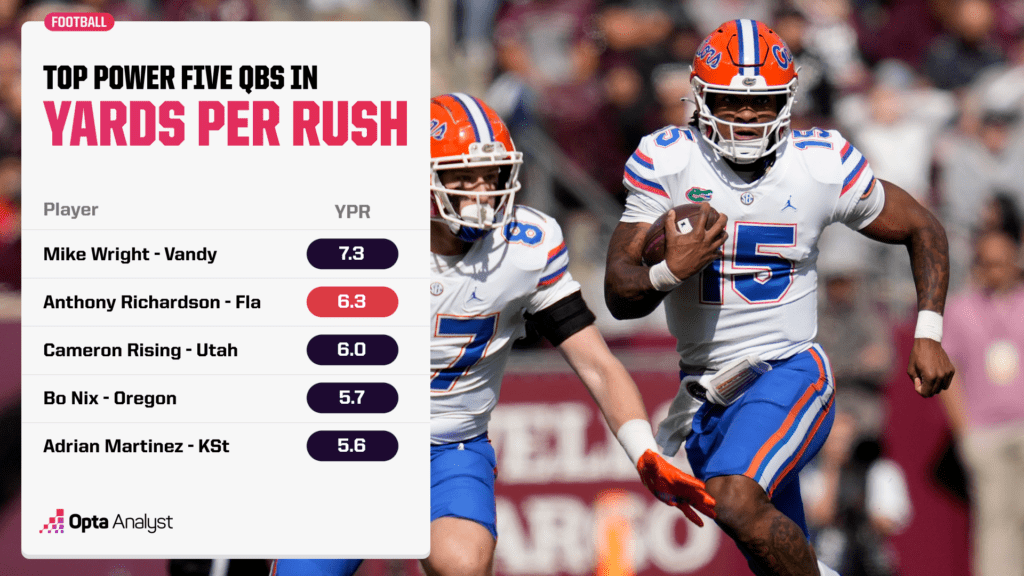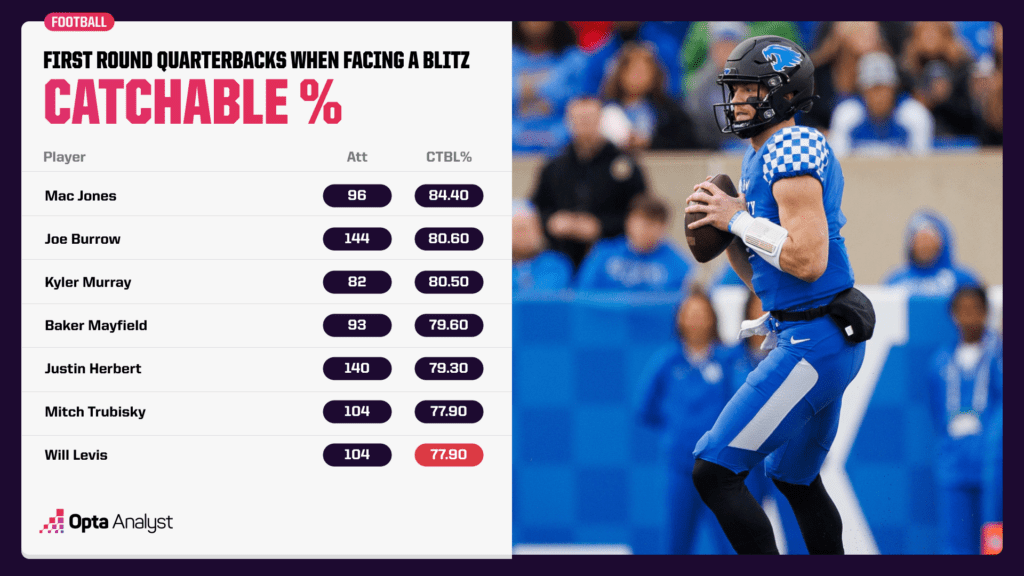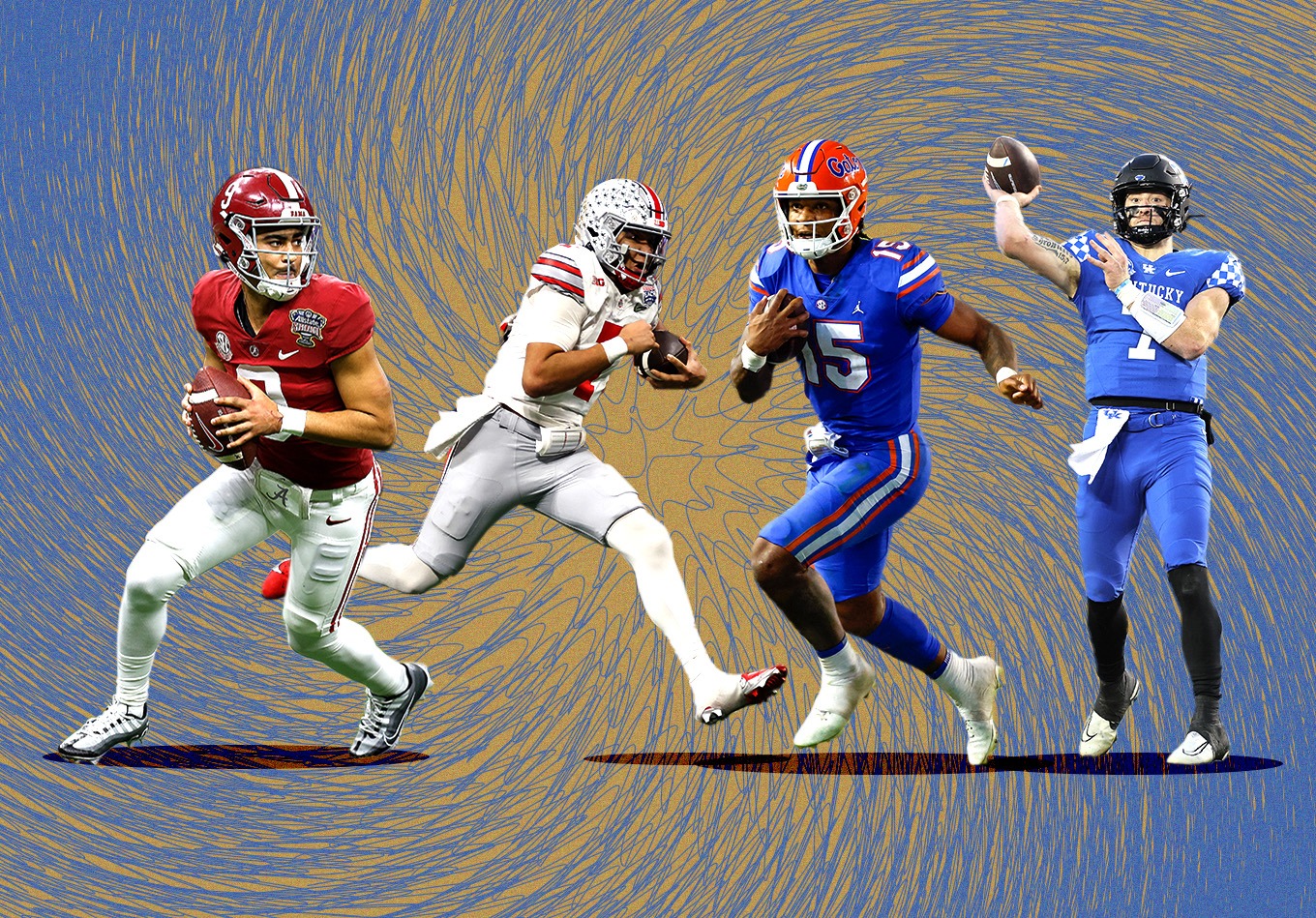NFL Draft QB Quick Hits
- Anthony Richardson’s 6.3 yards per rush were second among Power 5 quarterbacks in 2022.
- Bryce Young’s 2.21 pickable pass percentage ranked fourth in FBS among QBs with at least 360 passing attempts.
- C.J. Stroud’s 177.7 QB rating led the FBS.
- Will Levis posted an elite 77.9 catchable ball percentage when facing the blitz.
- Hendon Hooker’s 9.53 pass yards per attempt were first in the FBS.
We’re just one day away from the start of the NFL Draft, with the quarterback-needy Carolina Panthers on the clock after their blockbuster trade with the Chicago Bears.
Anthony Richardson, Bryce Young, C.J. Stroud and Will Levis are the top four quarterback prospects on most big boards. This group of signal callers is unique because they each have different strengths and weaknesses, ones that will require teams to make broad determinations about exactly the type of QB they want leading their team onto the field.
And with that in mind, it seems only fitting that we do a deep dive into each of them. What will these top prospects bring to their new teams at the next level? And more importantly, what does the data say?
Anthony Richardson, Florida
Key Data Point: 6.3 yards per rush – second among all Power 5 quarterbacks.
Did you see Richardson’s NFL Combine? He ran a 4.43 40-yard dash – the exact same time as Justin Jefferson – and clocked a 1.53 10-yard split. In case you’re wondering, Tyreek Hill’s 10-yard split was 1.50. And that’s without even mentioning his combine-record numbers in both the broad jump and vertical jump.
He’s entering a league with some of the greatest athletes in the world, and he’s already among the freakiest. We got a good sneak peek of how that might look when Richardson dominated athletes in the SEC – the conference that has had the most players drafted for 16 consecutive years – to the tune of 6.3 yards per rush. That was the second most among all Power 5 quarterbacks.

Of course, playing the quarterback position is more than just running around and Richardson also offers QB-needy NFL teams like the Panthers, Indianapolis Colts, Houston Texans and Tennessee Titans the best arm strength of any quarterback in the class. Case in point, his career-long completion in air yards (53 yards) is farther than any completion Patrick Mahomes had while in college and is only 1 yard off Josh Allen’s career long with the Buffalo Bills.
There’s a but coming, because if that was the end of Richardson’s story he’d be the surefire No. 1 pick. But, just like Allen at Wyoming, Richardson can struggle with accuracy. Among 118 qualified FBS quarterbacks, Richardson’s 53.8 completion percentage ranked 111th.
Furthermore, his 69.1 well-thrown percentage would be by far the worst mark of the first-round quarterbacks. Since 2016, the average among quarterbacks selected in the first round during their draft year has been 76.5%.
In a nutshell, this is why Richardson has drawn comparisons to Allen. Richardson enters the NFL with elite tools and a cannon for an arm, but he’s ultimately pretty raw with some accuracy issues. Patience will be key for the organization that selects Richardson, but like Allen, he may have the highest upside of any of the four quarterbacks.
Bryce Young, Alabama
Key Data Point: 1.64 pickable pass percentage – second among QBs with at least 360 passing attempts in their draft year since 2016.
For the most part, Young has been the betting favorite to be the top quarterback selected throughout this entire process and interestingly, he and Richardson are as close to polar opposites as two quarterbacks in the running to go first overall can be. Whereas Richardson lit up the combine and college film with his stature and athletic tools, Young’s tape shows incredible poise and decision-making.
With Young, let’s get the elephant in the room out of the way right now. Young weighed in at 204 pounds and was measured as just a shade above 5-foot-10. When Young is drafted, he will become the lightest quarterback drafted in the first round since 2006 and match Kyler Murray for the distinction of shortest quarterback ever drafted.
Critically, Young does not possess the jitterbug movement of Murray, nor does he possess the speed or agility of Michael Vick, who, at 210 pounds, was among the lightest quarterbacks drafted before Murray went first overall.
But once you get past his stature, Young’s tape is littered with uncanny poise and intelligence. Young’s elite trait is his ability to not only throw accurate passes, but more specifically, avoid throwing pickable passes. No matter whether he was throwing downfield, facing a blitz or an eight-man drop, or on the move to either side of the field, Young simply did not give his opponents much of a chance to turn his team over.
His 2.21 pickable pass percentage last season is miles ahead of the other three quarterbacks projected to go in the first round in most NFL mock drafts.
Young, who led his team to the playoffs and national championship game as a sophomore, is unlike any other quarterback we’ve seen. If he was simply 4 inches and 15 pounds heavier, he’d be talked about as a can’t-miss prospect by talent evaluators.
Whichever team drafts Young will always have its fingers crossed that he can deal with the rigors of being an NFL player. But that team will also be selecting a player that only threw 12 interceptions in 34 games at Alabama, has plenty of escapability should he need to face oncoming rushers, and oh yeah, plenty of arm talent.
You see, Young also had a completion of 53 air yards last season. So Richardson isn’t the only one with that feather in his cap.
C.J. Stroud, Ohio State
Key Data Point: 177.7 QB rating – led the FBS last season.
Stroud is the best pure thrower of the football in this class, and one of the best draft prospects as a passer since Andrew Luck. That may seem like hyperbole, but Stroud’s highlights showcase a player who is elite at hitting wide receivers in stride whether they’re 5, 15, or 40 yards downfield.
But maybe most important is Stroud’s ability to throw a great ball when his receiver is blanketed by excellent coverage. Remember his throw in the Rose Bowl two seasons ago? Or this throw from Stroud to Marvin Harrison Jr. against Iowa this past season?’
When it comes to his skill set, the data backs up the film. There are 45 quarterbacks with a catchable percentage of at least 78.7. Stroud’s open target percentage – which measures how often a QB throws to an open receiver – is the second lowest among that group. Additionally, his average air yards per throw was the fifth highest. In layman’s terms, Stroud was throwing balls that were catchable to receivers well downfield who weren’t always open.
If you want your quarterback to be elite at throwing the pigskin, Stroud is your guy. But think of all the best quarterbacks in the NFL today. Every one of them offers mobility and scrambling that keeps the offense on track. And while Stroud does have the ability to scramble, he was reluctant to do so throughout his entire Ohio State career.
With the caveat in place that sacks count towards rushing yards in college football, Stroud rushed for 136 net yards. In his entire collegiate career. And if you take away all of his negative rushes, that number only climbs to 346 yards. Stroud will routinely turn down easy 10-yard rushes for a downfield throw, even if it’s a third-and-7 and the situation dictates that Stroud just pick up the first down.
Whether or not teams find Stroud’s lack of a rushing profile because of the trust he has in his arm a detriment will depend on organizational preference. But one thing is for sure: Whichever team drafts Stroud will be inheriting someone whose best trait aligns with the hardest part of playing the position.
Stroud is the premier passer in this draft class.
Will Levis, Kentucky
Key Data Point: 77.90 catchable ball percentage when facing the blitz.
In 24 games with Kentucky over his final two seasons, Levis threw 23 interceptions.
Of the 408 quarterbacks that have become draft eligible since 2016, Levis ranks 283rd in our “choice” metric – which measures a combination of air yards and whether or not a target is open. Making good “choices” means you’re throwing deeper downfield to open receivers. His ranking tells us that Levis was throwing closer to the line of scrimmage to receivers that were more than likely not open.
Only three quarterbacks were drafted in the first round after performing worse in the metric – Daniel Jones, Dwayne Haskins and Josh Rosen. That doesn’t exactly inspire much confidence in Levis, who played his first two years at Penn State.
Unfortunately, the 2022 season doesn’t paint a pretty picture because Levis and Kentucky weren’t nearly as good as they were in 2021. Entering this past season, Levis lost his top offensive weapon (Wan’Dale Robinson) to the NFL Draft, his offensive coordinator to the Los Angeles Rams and his offensive line wasn’t nearly as strong as the previous year.
Combined with some injury issues, it was a nightmarish year for Levis. And yet, there were still some positives. In his last four games, including a game against eventual national champion Georgia, Levis had six touchdowns and only two interceptions. He also posted two of his four best quarterback ratings during this stretch.
In total, while his numbers dipped across the board, there are still some positive indicators. None more so than his 77.9 catchable ball percentage when facing the blitz. Here is the entire list of quarterbacks drafted in the first round since 2016 with a better mark than Levis’ percentage: Mac Jones, Joe Burrow, Murray, Baker Mayfield, Justin Herbert and Mitch Trubisky.

In case you’re counting, that’s three No. 1 overall picks, a second overall pick, a player who won NFL Rookie of the Year (Herbert), and a player who finished in second (Jones, to some guy named Ja’Marr Chase).
And yes, his number is significantly ahead of Stroud, Young and Richardson.
Hendon Hooker, Tennessee
Key Data Point: 9.53 pass yards per attempt – first in the FBS.
A quick note on Hooker. He’s not in the running to be the first quarterback off the board, but our models love him. He ranks fifth in our combined QB ranking among all 408 quarterbacks during their draft-eligible seasons, just behind Mayfield, Burrow, Murray, Mac Jones, and just ahead of Jalen Hurts.
He played in a simple and quarterback-friendly offense at Tennessee, and as such, he made sound decisions with the ball every snap. His 9.53 pass yards per attempt led the FBS, as did his sterling 13.5 touchdown-to-interception ratio (27 touchdowns/two interceptions).
Hooker is an older prospect – he’s two months older than Justin Herbert (!!!) – and he’ll require some teaching when it comes to learning NFL lingo and a complex playbook, but whichever team takes him will get a player who put up largely huge numbers in college.
Hooker did, however, suffer a torn ACL in November, but is reportedly recovering very quickly. In fact, there have been reports that “multiple teams” have Hooker higher on their draft boards than Richardson.
Tanner McKee of Stanford, Dorian Thompson-Robinson of UCLA, Jake Haener of Fresno State, Clayton Tune of Houston and Stetson Bennett of Georgia figure to be the less attractive QB options after Hooker.
Enjoy this? Follow us on Twitter.
